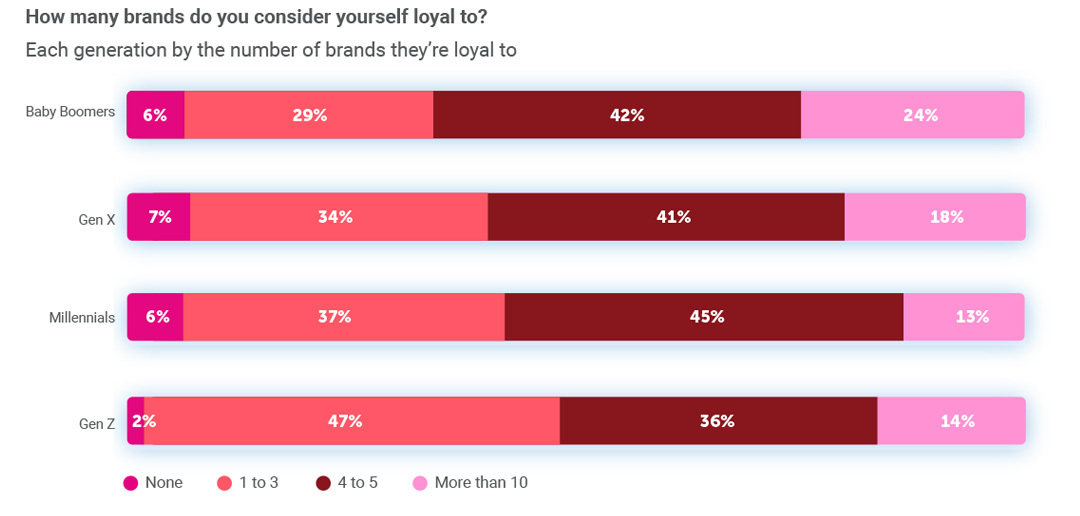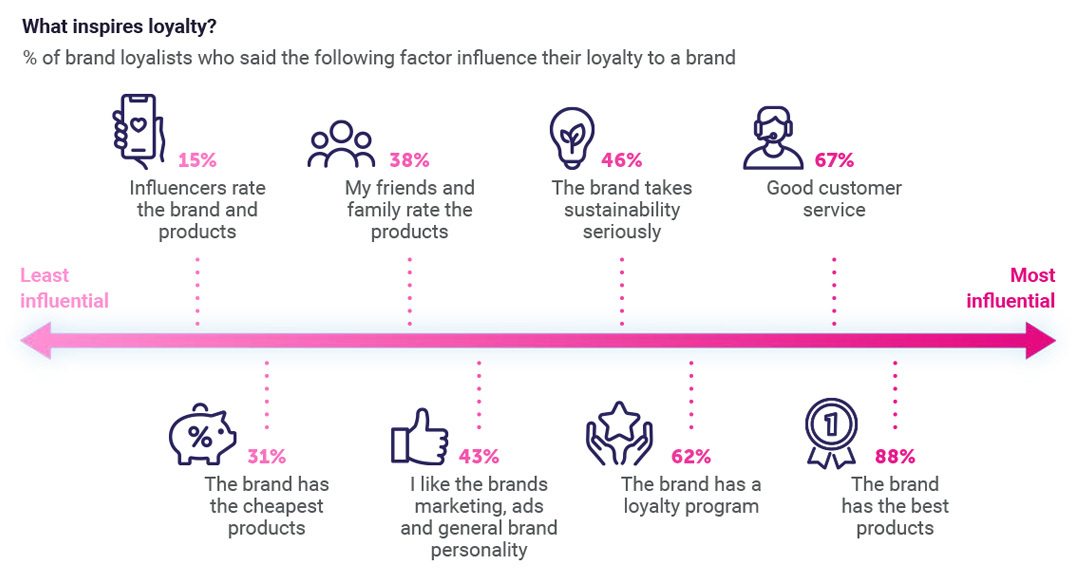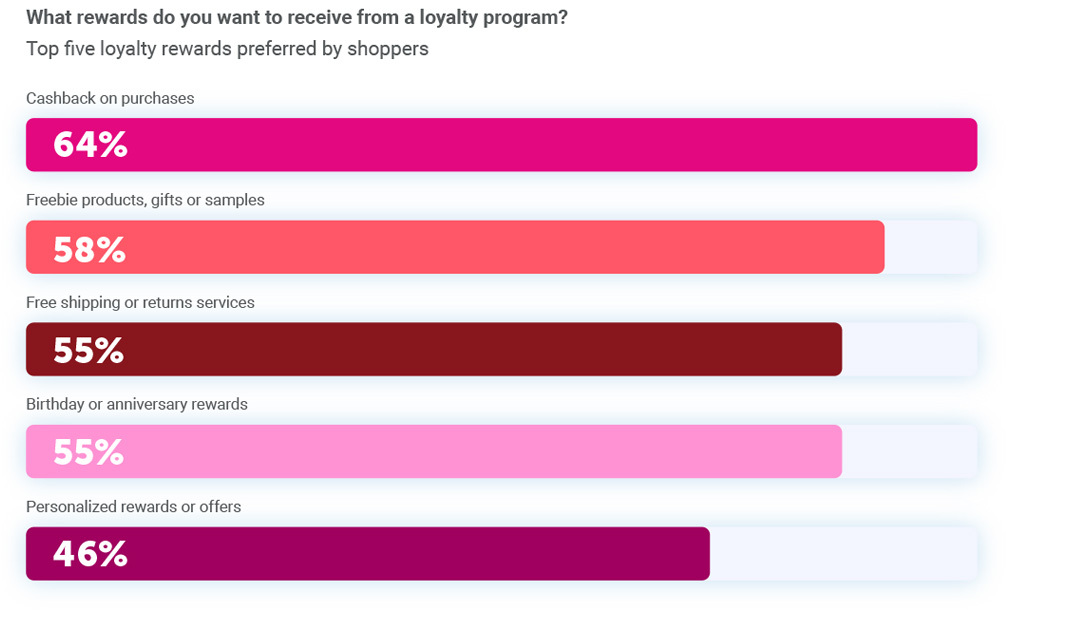A generational guide to building brand loyalty

Building brand loyalty is more challenging and more important than ever. Consumers are savvy, empowered, and have more choices than ever. This means that traditional, one-size-fits-all loyalty strategies are no longer effective. To truly connect with your audience, you need to understand what motivates each generation.
Our latest consumer insights report, The loyalty divide, reveals a clear split in how different age groups approach brand relationships. In this guide, we’ll draw on the findings from our report to break down loyalty generation by generation. We will also dig into what makes each age group convert, and give you practical tips for building brand loyalty that sticks.
So, whether your target audience is Gen Z, Gen X, or a combination of them all, you’ll learn about what they have in common, what divides them, and how to turn these insights into loyalty strategies that deliver results.
The loyalty landscape by generation
Understanding the basic differences between generations is the first step in smart generational marketing. Each age group has its own unique values, shopping habits, and factors that drive their brand loyalty. Let’s take a closer look at brand loyalty across different age groups in more detail.
Gen Z
Generation Z, born between 1997 and 2012, are the newest consumers, and their loyalty is fascinating. Many feel more connected to their favorite brands every year. In fact, 29% say they’re more loyal to the brands they love now compared to a year ago. This shows that they are looking for deeper, meaningful relationships with brands they trust and that match their evolving values.
What makes Gen Z’s loyalty unique is how intense and selective it is. While they might be loyal to fewer brands overall usually three or less their commitment to those chosen brands runs deep. About 61% of Gen Z consumers see themselves as “forever customers” for their favorites. It’s selective, but it’s strong.
Millennials
Millennials, born between 1981 and 1996, are a big deal when it comes to brand loyalty. They’re like the perfect link between people who grew up with the internet and those who remember life before it. This means they have unique expectations for brands. Even though they’re super comfortable with tech, they want more than just convenience. They’re looking for real connections and brands that truly align with their personal values.
Our customer loyalty report found that Millennials are the most willing to share their phone numbers with brands. This isn’t just about being good with digital tools. It shows they want easy, smooth, and direct online experiences. They’re happy to connect through different mobile channels because they value efficiency and getting the information right away.
Gen X
Generation X, born between 1965 and 1980, are incredibly practical when it comes to brands. They want real benefits, reliability, and straightforward experiences.
Even though many Gen Xers are comfortable with technology and often do more online research before buying than younger generations, their pragmatic side means they also highly value clear return policies. For them, using technology for convenience doesn’t mean sacrificing security, they want the confidence that if something isn’t right, sorting it out will be just as easy and clear as the initial purchase.
This preference for clear communication extends to why they respond well to traditional marketing like direct mail. It’s often direct and to the point, which they appreciate across all their interactions with brands.
This generation also shows strong brand loyalty, with 45% loyal to four to five brands. They’re also 13% more likely to use loyalty programs than the average consumer showing just how much they value rewards and reliable brand relationships.
Baby Boomers
Baby Boomers, born between 1946 and 1964, are really loyal to brands. They often stick with brands they’ve known and liked for a long time. They trust brands a lot and expect high quality from everything they buy.
It’s a big deal how committed they are to brands. About 24% of Boomers are loyal to several brands they believe in, sometimes showing loyalty to ten or more. Because of this long-term loyalty, they usually go back to brands they know are reliable and have proven their worth, rather than trying something new just because it’s trendy.

What drives purchase decisions across each generation?
What drives a Gen Z buyer is totally different from what matters to a Gen X or Millennial shopper. Each age group has its own set of values, habits, and influences when it comes to spending money. If you want to earn their loyalty, you need to understand what makes them tick.
Gen Z
For Gen Z, buying decisions are heavily influenced by what their peers think and what they see online. They’ve grown up with social media, so they trust the opinions of their friends and online communities a lot.
- Word-of-mouth influence: A whopping 55% are influenced by peer reviews. This means showing off real customer feedback is super important.
- Social approval: Their loyalty is tied to what their social circle thinks, with 47% staying loyal when friends and family approve. Building a positive brand image that resonates socially is key.
- Saving money: Even with all the trends, deals matter. 46% are motivated by discounts and special offers as they’re often budget-conscious.
- Influencer impact: While 28% are influenced by influencers, Gen Z prefers authentic, relatable content over flashy ads. Think micro-influencers who genuinely love your brand.
- Chatty brands: Gen Z loves to hear from brands often, with 68% more likely to be open to daily contact. This works because they’re loyal to fewer brands, so their inboxes aren’t overflowing.
Millennials
Millennials are unique because they blend being digital natives with valuing traditional shopping experiences. They use tech to make buying easier but also want genuine connections.
- Mobile-friendly: They’re very comfortable sharing phone numbers, opening the door for personalized texts or app messages.
- Messaging apps: They’re 34% more likely to opt into WhatsApp conversations, showing they like direct, immediate communication.
- Sense of urgency: They respond well to “act now” messages and time-sensitive offers, fitting their busy lifestyles.
- Seamless experiences: Millennials want brands that offer smooth online interactions. They’re great for campaigns that mix online and offline touches.
Gen X
Gen X approaches brands with a practical mindset. They’re discerning and value reliability, clear benefits, and easy experiences.
- Easy returns: 58% value free and easy returns, showing they want to know they can easily change their mind if a product isn’t right.
- Discounts: 56% are motivated by discounts and special offers. They appreciate direct savings.
- Direct mail: They still appreciate traditional methods, with 20% more likely to prefer direct mail.
- Consistent experience: 41% want a seamless experience across all communication channels, whether it’s email, mail, social media, or in-store.
Baby Boomers
Baby Boomers put product quality above all else. They value established trust, reliable service, and a proven track record. Their loyalty often comes from years of positive experiences.
- Quality: An overwhelming 88% focus on finding the best products. They’re patient researchers and willing to pay more for quality and dependable service.
- Free returns: Like Gen X, 57% appreciate practical benefits like free returns.
- Loyalty programs: Their loyalty program preferences are traditional with 76% preferring points-based programs.
- Thoughtful communication: Boomers prefer less frequent but more meaningful interactions. They like monthly communications that offer real value, detailed info, and clear benefits, not just constant sales pitches. For them, quality of communication beats quantity every time.
How to inspire loyalty across generations
If you want customers to stick around, it’s not just about what they buy, it’s about why they buy and what keeps them coming back. Loyalty isn’t one-size-fits-all. Different generations are motivated by different things, so the key is to understand what matters most to each group. Let’s dive into the loyalty programs and rewards that resonate, so you can build strategies that feel personal and effective.
Types of loyalty programs
There are lots of ways to reward your customers, but designing a program that works for everyone can be tricky. Each generation has its own preferences, so the goal is to find what truly motivates your audience and build from there.
Points-based programs
This is the classic approach. Customers earn points for things like purchases, signing up for emails, or referring friends. Over time, those points add up and can be traded in for discounts, freebies, or exclusive products.
Think of it like a digital stamp card: the more you engage, the more points you collect, and the bigger the reward. This system works well for customers who enjoy seeing their efforts build up over time towards a larger goal.
Gifts and freebies
Sometimes, people just want a little something now. These programs offer instant rewards like a free gift with a purchase, a birthday treat, or a surprise after spending a certain amount.
It’s all about that feel-good moment. A small, unexpected perk can go a long way in making someone feel appreciated and excited to come back.
Subscription-based loyalty
A subscription loyalty model is a bit different. Instead of earning rewards, customers pay a monthly or yearly fee to unlock ongoing benefits like free shipping, early access to new products, or exclusive discounts.
It’s a great way to build long-term loyalty by offering consistent value. If the perks are worth it, people are happy to stick around and feel like VIPs.

Tailoring rewards by generation
The kind of rewards you offer can make or break your loyalty program. Here’s what works best for each generation:
- Gen Z: They love instant rewards—think freebies, birthday surprises, and personalized discounts. Quick wins and fun perks keep them engaged.
- Millennials: They like a mix. Cashback and free stuff both appeal to them, especially when it feels like a smart deal.
- Gen X: They are practical and value-driven. Free shipping and cashback are big winners here. They want rewards that make life easier or save money.
- Baby Boomers: They’re in it for the long haul. Points programs and cashback that lead to meaningful savings are what they trust and appreciate most.

How to measure customer loyalty
Loyal customers stay longer, spend more, and turn into your biggest fans. While customer loyalty might seem like just a feeling, you can measure it using clear, actionable data. Let’s dig into the key metrics that show you how strong your customer relationships are.
Net promoter score (NPS)
NPS measures how likely your customers will recommend your brand to their friends or family. You ask them to pick a number from 0 to 10.
Any customer who chooses a score between zero and six is considered a ‘detractor’, seven and eight are considered ‘passives’, and nine and ten are considered ‘promoters’
- Promoters (9-10): These are loyal, enthusiastic customers who will recommend you.
- Passives (7-8): They’re satisfied but not passionate. They might switch to a competitor.
- Detractors (0-6): These are unhappy customers who could speak negatively about your brand.
To calculate your NPS, you subtract the percentage of Detractors from the percentage of Promoters. A higher score directly reflects happier, more loyal customers.
Your NPS isn’t just a single number; it’s a dynamic indicator of customer happiness and loyalty. By using NPS surveys at different points in the customer journey—say, after a purchase or upon exiting your service—you can pinpoint specific areas of satisfaction or dissatisfaction.
Tracking your NPS regularly helps you spot trends, quickly address any drops in loyalty, and proactively work to boost your customer’s overall experience. Its straightforward format also ensures high response rates, giving you reliable insights.
Customer retention rate
This metric tells you the percentage of customers your business keeps over a specific period. It directly shows how good you are at holding onto your existing customers.
Calculation:
((Number of customers at end of period – new customers acquired during period) / number of customers at beginning of period) x 100
A high retention rate is a strong sign that customers are happy, find continued value in what you offer, and choose to stay with your business.
Customer lifetime value (CLV)
CLV estimates the total revenue a customer is expected to generate for your business throughout their entire relationship with you.
Basic calculation:
Average purchase value × average purchase frequency × average customer lifespan
A high CLV indicates customers are not just loyal, but also consistently buy from you over a long time, contributing significantly to your long-term profits.
By tracking these metrics, you gain a clear picture of your customer loyalty.
Start building loyalty today
Building customer loyalty is about understanding the different generations you’re trying to reach. When you connect with people in a way that feels real and relevant to them, you build trust. And with the right approach, you can create loyalty that lasts across generations.



